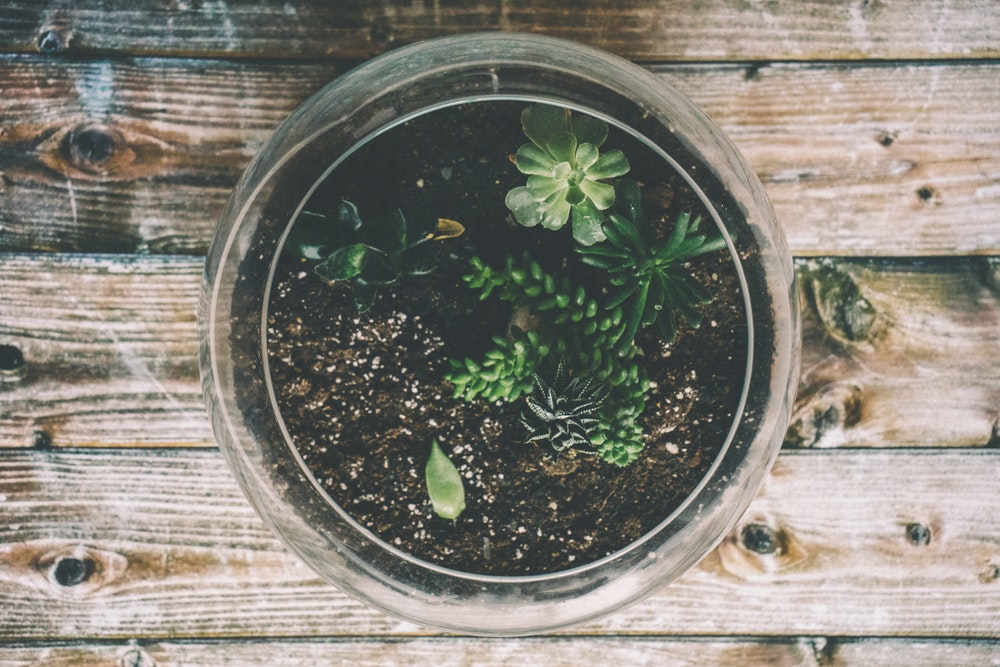Terrariums 101: How to build your own
Looking for a better way to decorate your desk? Newly arrived international students can make their rooms seem livelier with a plant. While regular plants are high maintenance, a terrarium can be an easy way to have some greenery into your room with little effort.
A terrarium is a transparent glass container containing soil and plants that can easily brighten up your room. It’s often kept as an ornamental item since it allows the plants to grow within the small ecosystem created by itself and requires very little maintenance.
Terrariums can be classified into two types by the container: open and closed.
An open terrarium allows the plantations to be exposed to the air directly. It is suitable for the plants that prefer an arid, dry environment, such as succulents, cacti, and air plants. Usually, a slight amount of water will be needed once or twice per month.
A closed terrarium has a lid so it can create a small ecosystem within itself. Moisture loving plants like ferns are more likely to thrive in a closed terrarium. The moisture from both the soil and plants evaporates, condenses on the container, and eventually falls back to the soil, so that a constant supply of water can be ensured.
Not only are terrariums beautiful but easy to DIY as well. They should not cost much money to make and if you share materials with friends, it will cost a fraction of store-bought terrariums. This way, you can also customise the type of plants and look of your terrarium to match your room.
How to Build a Terrarium
What you’ll need: A clean transparent container, small pebbles, dried spongy moss, peat soil, plants (You can pink succulents, cacti, nerve plants, or anything you like but make sure the plants that you’ve chosen have similar habitat needs), a spoon, a bowl of water and a pair of scissors.
All the materials can be found in gardening shops or home improvement stores like Bunnings.
Step 1:

Image source: Illustration by Ziyuan Cui
Find a container. It can be anything from a reused pickle jar to a vintage vase. Just make sure the container is clean and transparent, since the colour on the container could hinder the growth.
Step 2:

Image source: Illustration by Ziyuan Cui
Place a handful of pebbles at the bottom of the container. This layer helps to shape the terrain while aiding drainage and aeration. Make sure to pack the pebbles flat to make for a good foundation layer.
Step 3:

Image source: Illustration by Ziyuan Cui
Soak the dried spongy moss in water for a few seconds and squeeze out the excess liquid. Place the moss onto the pebbles, pat it down so that it fills the entire surface area and forms a barrier that keeps the soil from falling into the rocks. This layer can absorb and store water, which helps to adjust the humidity inside the terrarium.
Step 4:

Image source: Illustration by Ziyuan Cui
Scoop the soil and fill it into the container. The peat soil can drain away the extra water.
Step 5:

Image source: Illustration by Ziyuan Cui
Get planting. Use scissors to trim the plants into proper shapes if it is needed, and make sure to press down the soil around the plants firmly. Make sure the roots are completely covered by the soil.
Step 6:

Image source: Illustration by Ziyuan Cui
Water the soil around the roots of the plants with the spoon. Please keep in mind that succulents and cacti do not need much water. Though the pebble layer will work as a drainage, the container doesn’t have drainage holes like a pot does so excess water sitting in the soil layer will cause roots to rot. Be careful not to leave too much water on the leaves of succulents because they are likely to get diseases when it’s too wet. Then you are done!
This story was produced by Media and Communication students at Trinity College Foundation Studies as part of Meld’s community newsroom collaboration. Education institutions, student clubs/societies and community groups interested in being involved can get in touch with us via meld@meldmagazine.com.au.
